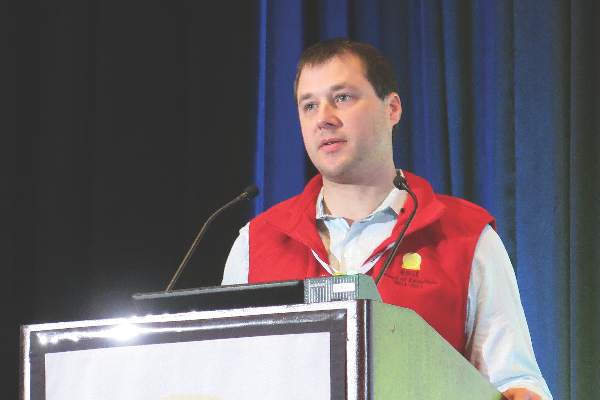User login
LAKE BUENA VISTA, FLA. – Contrary to prior results, use of onabotulinumtoxinA did not improve primary fascial closure rates after damage control laparotomy in a multicenter, prospective study.
“Botox injections were safe, but they did not have any effect on our primary or secondary endpoints,” Dr. Martin D. Zielinski said at the annual scientific assembly of the Eastern Association for the Surgery of Trauma (EAST).
Dr. Zielinski and his colleagues at Mayo Clinic, Rochester, Minn., previously published retrospective data showing that use of Botox-induced paralysis of the abdominal wall musculature resulted in a primary fascial closure rate of 83% among 18 patients with open abdomen (OA) and 89% if injected within 24 hours of the initial OA procedure (Hernia 2013;17:101-7).
In contrast, the primary closure rate was just 66% in a prospective American Association for the Surgery of Trauma study involving 572 patients requiring OA management after damage control laparotomy (J. Trauma Acute Care Surg. 2013;74:113-20).
Though negative pressure dressings and use of patches have been shown to increase primary closure by facilitating the midline tension, up to 30% of patients will not achieve primary fascial closure. Botox injections block the release of acetylcholine, thereby preventing a rush of calcium to the abdomen and inducing flaccid paralysis of the lateral abdominal wall muscles, Dr. Zielinski explained.
To test their hypothesis that Botox would improve rates of primary fascial closure, decrease hospital stay, and enhance pain control, 46 patients who had undergone damage control laparotomy were randomly assigned to six separate injections of their external, oblique, internal oblique, and transverse abdominal muscles with 150 cc/injection of Botox A or sodium chloride 0.9%.
The two groups were well matched, with the exception of Botox patients having a significantly lower body mass index (BMI) than did controls (30 kg/m2vs. 26.3 kg/m2) and receiving more intraoperative packed red blood cells (8 units vs. 4.8 units).
Primary fascial closure rates were unexpectedly high, but did not differ between the Botox and control groups (96% vs. 93%; hazard ratio, 1.0), Dr. Zielinski said.
Secondary endpoints were also similar between the Botox and control groups including average time until closure (5 days vs. 2 days; P = .15), hospital stay (24 days vs. 19 days; P = .19), median ICU duration (8 days vs. 6 days; P = 32), and wound infection rate (8% vs. 0%; P > .99).
Given the potential pain effects of Botox, the investigators anticipated a difference in pain medication use, but morphine equivalents were actually slightly higher in the Botox group on postoperative day 1 (120 mg vs. 81.8 mg; P = .27) through day 5 (57.3 vs. 49.0 mg; P = .47), he said.
In trying to explain why the injections failed to prove beneficial, Dr. Zielinski said, “The question that crosses my mind is did we exclude the wrong patients?”
A total of 181 trauma or emergency general surgery patients, aged 18 years and older, with a damage-control laparotomy per the surgeon’s discretion were eligible for the double-blind study, but 87 were excluded because they had one or more exclusion criterion: a body mass index ≥ 50, hemodynamic instability, complicated chronic obstructive pulmonary disease, impaired neuromuscular transmission, aminoglycoside use, international normalized ratio < 1.5, trunk necrotizing fasciitis, metastatic malignancy, or were pregnant or a prisoner.
Discussant Michael Rotondo of the University of Rochester (New York) Medical Center, applauded the authors for presenting a negative study and called it “impeccably designed” and “a great piece of work.”
Dr. Rotondo went on to ask whether there was any relationship between degree of advancement, abdominal breach, or lateral diameter that predicts success with Botox.
Despite the use of surface wave elastography to measure abdominal tension in eight patients and use of a handheld durometer, Dr. Zielinski said they were unable to accurately measure degree of advancement. Future work may look at the relationship between these factors and will include long-term follow-up to evaluate hernia rates and quality of life. In the one patient with full elastography measurements, abdominal tension trended lower for 2 days after the Botox injection before increasing after primary closure, he said.abdominal tension trended lower for 2 days after the Botox injection before increasing after primary closure, he said.
The study was funded by the EAST Scholar program. Dr. Zielinski, his coauthors, and Dr. Rotondo reported having no financial disclosures.
LAKE BUENA VISTA, FLA. – Contrary to prior results, use of onabotulinumtoxinA did not improve primary fascial closure rates after damage control laparotomy in a multicenter, prospective study.
“Botox injections were safe, but they did not have any effect on our primary or secondary endpoints,” Dr. Martin D. Zielinski said at the annual scientific assembly of the Eastern Association for the Surgery of Trauma (EAST).
Dr. Zielinski and his colleagues at Mayo Clinic, Rochester, Minn., previously published retrospective data showing that use of Botox-induced paralysis of the abdominal wall musculature resulted in a primary fascial closure rate of 83% among 18 patients with open abdomen (OA) and 89% if injected within 24 hours of the initial OA procedure (Hernia 2013;17:101-7).
In contrast, the primary closure rate was just 66% in a prospective American Association for the Surgery of Trauma study involving 572 patients requiring OA management after damage control laparotomy (J. Trauma Acute Care Surg. 2013;74:113-20).
Though negative pressure dressings and use of patches have been shown to increase primary closure by facilitating the midline tension, up to 30% of patients will not achieve primary fascial closure. Botox injections block the release of acetylcholine, thereby preventing a rush of calcium to the abdomen and inducing flaccid paralysis of the lateral abdominal wall muscles, Dr. Zielinski explained.
To test their hypothesis that Botox would improve rates of primary fascial closure, decrease hospital stay, and enhance pain control, 46 patients who had undergone damage control laparotomy were randomly assigned to six separate injections of their external, oblique, internal oblique, and transverse abdominal muscles with 150 cc/injection of Botox A or sodium chloride 0.9%.
The two groups were well matched, with the exception of Botox patients having a significantly lower body mass index (BMI) than did controls (30 kg/m2vs. 26.3 kg/m2) and receiving more intraoperative packed red blood cells (8 units vs. 4.8 units).
Primary fascial closure rates were unexpectedly high, but did not differ between the Botox and control groups (96% vs. 93%; hazard ratio, 1.0), Dr. Zielinski said.
Secondary endpoints were also similar between the Botox and control groups including average time until closure (5 days vs. 2 days; P = .15), hospital stay (24 days vs. 19 days; P = .19), median ICU duration (8 days vs. 6 days; P = 32), and wound infection rate (8% vs. 0%; P > .99).
Given the potential pain effects of Botox, the investigators anticipated a difference in pain medication use, but morphine equivalents were actually slightly higher in the Botox group on postoperative day 1 (120 mg vs. 81.8 mg; P = .27) through day 5 (57.3 vs. 49.0 mg; P = .47), he said.
In trying to explain why the injections failed to prove beneficial, Dr. Zielinski said, “The question that crosses my mind is did we exclude the wrong patients?”
A total of 181 trauma or emergency general surgery patients, aged 18 years and older, with a damage-control laparotomy per the surgeon’s discretion were eligible for the double-blind study, but 87 were excluded because they had one or more exclusion criterion: a body mass index ≥ 50, hemodynamic instability, complicated chronic obstructive pulmonary disease, impaired neuromuscular transmission, aminoglycoside use, international normalized ratio < 1.5, trunk necrotizing fasciitis, metastatic malignancy, or were pregnant or a prisoner.
Discussant Michael Rotondo of the University of Rochester (New York) Medical Center, applauded the authors for presenting a negative study and called it “impeccably designed” and “a great piece of work.”
Dr. Rotondo went on to ask whether there was any relationship between degree of advancement, abdominal breach, or lateral diameter that predicts success with Botox.
Despite the use of surface wave elastography to measure abdominal tension in eight patients and use of a handheld durometer, Dr. Zielinski said they were unable to accurately measure degree of advancement. Future work may look at the relationship between these factors and will include long-term follow-up to evaluate hernia rates and quality of life. In the one patient with full elastography measurements, abdominal tension trended lower for 2 days after the Botox injection before increasing after primary closure, he said.abdominal tension trended lower for 2 days after the Botox injection before increasing after primary closure, he said.
The study was funded by the EAST Scholar program. Dr. Zielinski, his coauthors, and Dr. Rotondo reported having no financial disclosures.
LAKE BUENA VISTA, FLA. – Contrary to prior results, use of onabotulinumtoxinA did not improve primary fascial closure rates after damage control laparotomy in a multicenter, prospective study.
“Botox injections were safe, but they did not have any effect on our primary or secondary endpoints,” Dr. Martin D. Zielinski said at the annual scientific assembly of the Eastern Association for the Surgery of Trauma (EAST).
Dr. Zielinski and his colleagues at Mayo Clinic, Rochester, Minn., previously published retrospective data showing that use of Botox-induced paralysis of the abdominal wall musculature resulted in a primary fascial closure rate of 83% among 18 patients with open abdomen (OA) and 89% if injected within 24 hours of the initial OA procedure (Hernia 2013;17:101-7).
In contrast, the primary closure rate was just 66% in a prospective American Association for the Surgery of Trauma study involving 572 patients requiring OA management after damage control laparotomy (J. Trauma Acute Care Surg. 2013;74:113-20).
Though negative pressure dressings and use of patches have been shown to increase primary closure by facilitating the midline tension, up to 30% of patients will not achieve primary fascial closure. Botox injections block the release of acetylcholine, thereby preventing a rush of calcium to the abdomen and inducing flaccid paralysis of the lateral abdominal wall muscles, Dr. Zielinski explained.
To test their hypothesis that Botox would improve rates of primary fascial closure, decrease hospital stay, and enhance pain control, 46 patients who had undergone damage control laparotomy were randomly assigned to six separate injections of their external, oblique, internal oblique, and transverse abdominal muscles with 150 cc/injection of Botox A or sodium chloride 0.9%.
The two groups were well matched, with the exception of Botox patients having a significantly lower body mass index (BMI) than did controls (30 kg/m2vs. 26.3 kg/m2) and receiving more intraoperative packed red blood cells (8 units vs. 4.8 units).
Primary fascial closure rates were unexpectedly high, but did not differ between the Botox and control groups (96% vs. 93%; hazard ratio, 1.0), Dr. Zielinski said.
Secondary endpoints were also similar between the Botox and control groups including average time until closure (5 days vs. 2 days; P = .15), hospital stay (24 days vs. 19 days; P = .19), median ICU duration (8 days vs. 6 days; P = 32), and wound infection rate (8% vs. 0%; P > .99).
Given the potential pain effects of Botox, the investigators anticipated a difference in pain medication use, but morphine equivalents were actually slightly higher in the Botox group on postoperative day 1 (120 mg vs. 81.8 mg; P = .27) through day 5 (57.3 vs. 49.0 mg; P = .47), he said.
In trying to explain why the injections failed to prove beneficial, Dr. Zielinski said, “The question that crosses my mind is did we exclude the wrong patients?”
A total of 181 trauma or emergency general surgery patients, aged 18 years and older, with a damage-control laparotomy per the surgeon’s discretion were eligible for the double-blind study, but 87 were excluded because they had one or more exclusion criterion: a body mass index ≥ 50, hemodynamic instability, complicated chronic obstructive pulmonary disease, impaired neuromuscular transmission, aminoglycoside use, international normalized ratio < 1.5, trunk necrotizing fasciitis, metastatic malignancy, or were pregnant or a prisoner.
Discussant Michael Rotondo of the University of Rochester (New York) Medical Center, applauded the authors for presenting a negative study and called it “impeccably designed” and “a great piece of work.”
Dr. Rotondo went on to ask whether there was any relationship between degree of advancement, abdominal breach, or lateral diameter that predicts success with Botox.
Despite the use of surface wave elastography to measure abdominal tension in eight patients and use of a handheld durometer, Dr. Zielinski said they were unable to accurately measure degree of advancement. Future work may look at the relationship between these factors and will include long-term follow-up to evaluate hernia rates and quality of life. In the one patient with full elastography measurements, abdominal tension trended lower for 2 days after the Botox injection before increasing after primary closure, he said.abdominal tension trended lower for 2 days after the Botox injection before increasing after primary closure, he said.
The study was funded by the EAST Scholar program. Dr. Zielinski, his coauthors, and Dr. Rotondo reported having no financial disclosures.
AT THE EAST SCIENTIFIC ASSEMBLY
Key clinical point: The use of Botox to induce flaccid paralysis of the abdominal wall muscles is of questionable value in achieving primary facial closure.
Major finding: Primary fascial closure rates did not differ between the Botox and control groups (96% vs. 93%; HR, 1.0).
Data source: Prospective randomized trial in 46 patients who had undergone damage control laparotomy.
Disclosures: The study was funded by the EAST Scholar program. Dr. Zielinski, his coauthors, and Dr. Rotondo reported having no financial disclosures.


